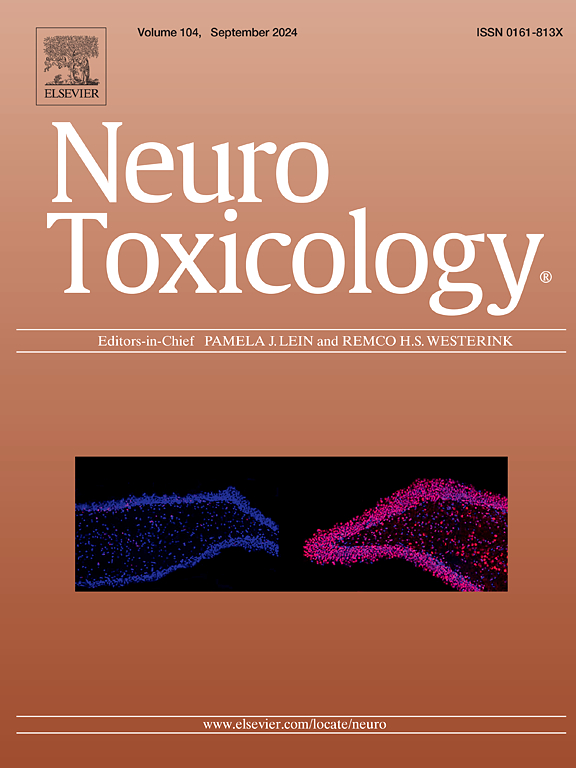900 MHz射频暴露后啮齿动物脑细胞发育的改变
IF 3.9
3区 医学
Q2 NEUROSCIENCES
引用次数: 0
摘要
与900 MHz 2 G频率接触有关的健康风险在目前的监管标准下仍然没有定论。对潜在长期影响的研究正在进行中,特别是随着移动网络和无线设备使用的增加。本研究探讨手机900 MHz射频电磁场(RF-EMF)的非热暴露水平对啮齿动物神经发育的影响。在体内,研究人员评估了产前和产后0.08和0.4 W/kg特定吸收率(SAR)暴露对出生后第0天(PND 0)蛋白质组学谱的影响。脑源性神经营养因子(BDNF)、BrdU+ 增殖细胞、突触发生和氧化应激在PND 8和PND 17大鼠幼崽的海马和皮层。体外评估最低SAR(0.08 W/kg)对神经干细胞(NSCs)分化的影响,以提供机制数据。体内实验结果显示BDNF水平和BrdU+ 增生细胞减少,突触平衡(兴奋性突触/抑制性突触)减少。在体外,0.08 W/kg时,NSCs中Ki-67 + 增殖细胞、凋亡和双链DNA断裂增加。在暴露的NSCs中,B1细胞(NSCs的原代祖细胞)占总脑细胞的比例较低,少突胶质细胞祖细胞和星形胶质细胞的比例较高。我们的研究结果表明,大脑个体发生的关键细胞事件可能在早期发育期间随着RF-EMF 900 MHz的暴露而发生变化。这些结果支持了这样一种假设,即处于调节阈值的啮齿动物中,发育中的中枢神经系统易受RF-EMF暴露的影响。本文章由计算机程序翻译,如有差异,请以英文原文为准。
Altered development in rodent brain cells after 900 MHz radiofrequency exposure
Health risks related to 900 MHz 2 G frequency exposure remain inconclusive under current regulatory standards. Research into potential long-term effects is ongoing, particularly as the use of mobile networks and wireless devices increases. This study investigates the effects of non-thermal exposure levels of mobile phone 900 MHz radiofrequency electromagnetic field (RF-EMF) on rodent neurodevelopment. In vivo, the effects of pre- and post-natal 0.08 and 0.4 W/kg specific absorption rate (SAR) exposure were assessed for their impact on the proteomic profile at postnatal day 0 (PND 0). Brain-derived neurotrophic factor (BDNF), BrdU+ proliferative cells, synaptogenesis, and oxidative stress in the hippocampus and cortex of rat pups were studied at PND 8 and PND 17. Effects of the lowest SAR (0.08 W/kg) were assessed in vitro to afford mechanistic data regarding neural stem cells (NSCs) differentiation. In vivo results showed a decrease in BDNF level and BrdU+ proliferative cells with a decrease in synapse balance (excitatory synapses/inhibitory synapses). In vitro, at 0.08 W/kg there was an increase in Ki-67 + proliferative cells, apoptosis, and double-strand DNA breaks in NSCs. A lower ratio of B1 cells (primary progenitors of NSCs) among total cerebral cells and a higher ratio of oligodendrocyte progenitor cells and astrocytes were observed in the exposed NSCs. Our findings suggest that key cellular events for brain ontogenesis are likely to undergo changes with RF-EMF 900 MHz exposure during early development. These support the hypothesis that the developing central nervous system is vulnerable to RF-EMF exposures in rodents at regulatory thresholds.
求助全文
通过发布文献求助,成功后即可免费获取论文全文。
去求助
来源期刊

Neurotoxicology
医学-毒理学
CiteScore
6.80
自引率
5.90%
发文量
161
审稿时长
70 days
期刊介绍:
NeuroToxicology specializes in publishing the best peer-reviewed original research papers dealing with the effects of toxic substances on the nervous system of humans and experimental animals of all ages. The Journal emphasizes papers dealing with the neurotoxic effects of environmentally significant chemical hazards, manufactured drugs and naturally occurring compounds.
 求助内容:
求助内容: 应助结果提醒方式:
应助结果提醒方式:


